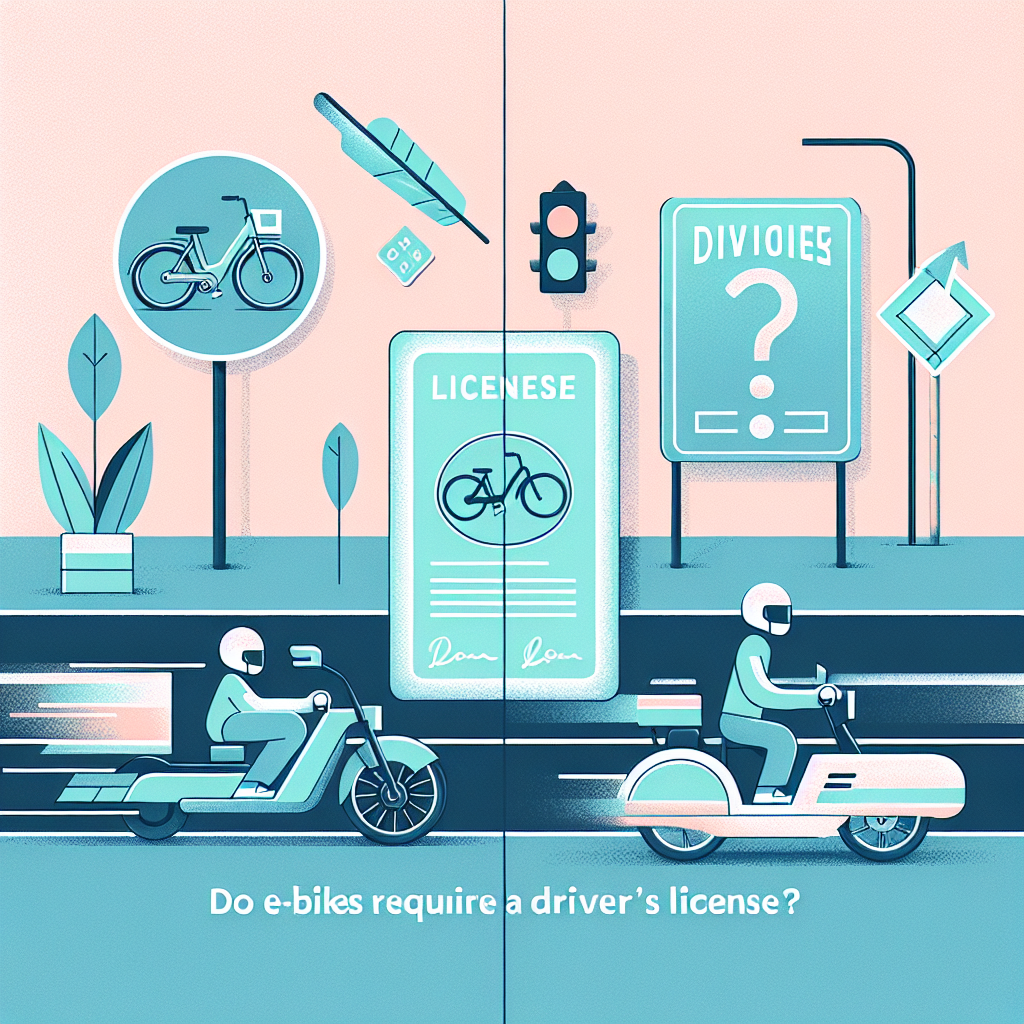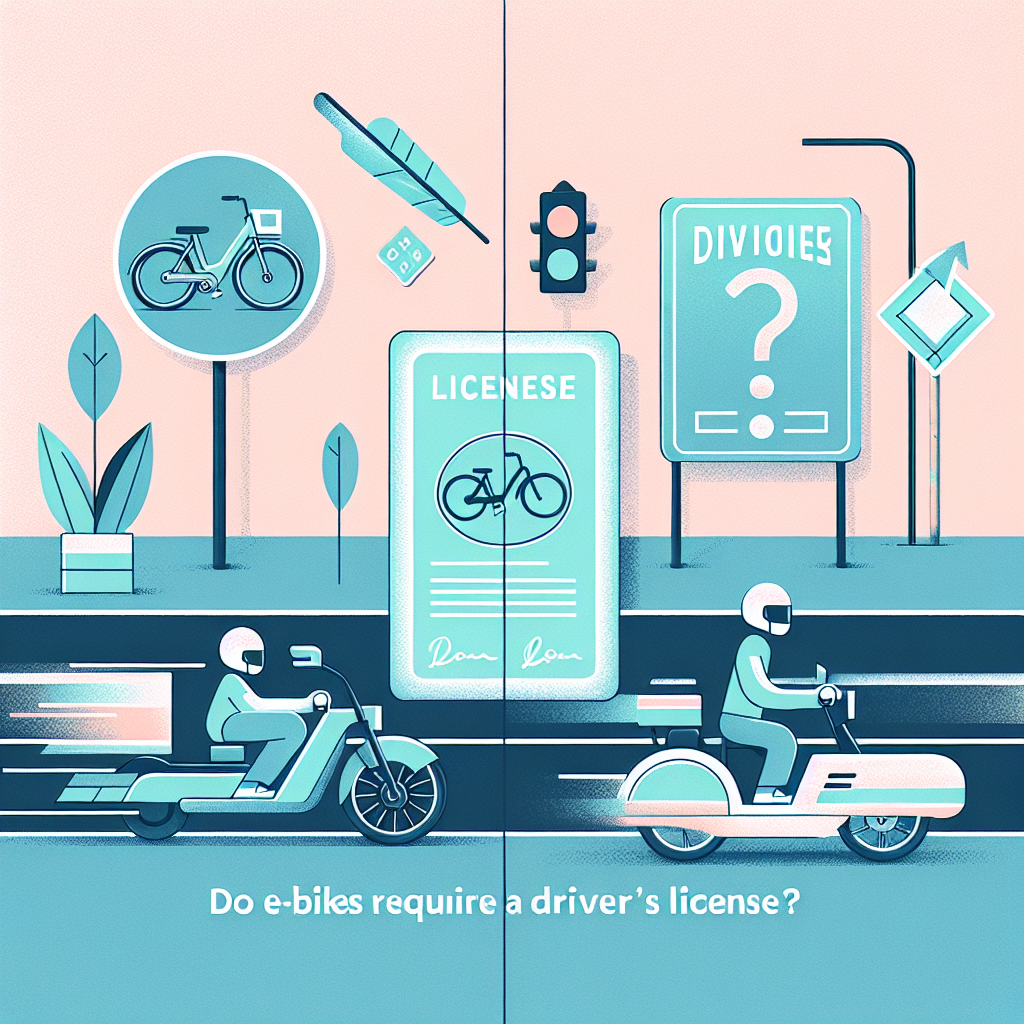If you’ve ever taken a leisurely stroll around your neighborhood, chances are you’ve noticed the growing popularity of e-bikes. These electric-powered bicycles have become a favorite mode of transportation for many, offering a convenient and eco-friendly alternative to traditional bikes and cars. But amidst the growing enthusiasm for e-bikes, a common question arises: do they require a driver’s license? In this article, we’ll explore the answer to this query and shed light on the regulations surrounding these innovative modes of transportation. So, grab your helmet and let’s hit the road to find out more!

Overview
What are e-bikes?
E-bikes, short for electric bicycles, are bicycles equipped with an electric motor and a rechargeable battery, which provide pedaling assistance to the rider. The motor can be activated by pedaling or using a throttle, allowing riders to easily navigate different terrains or cover longer distances with less effort. e-bikes are gaining popularity worldwide as a sustainable and convenient means of transportation, offering an eco-friendly alternative to traditional bicycles and motor vehicles.
Different types of e-bikes
There are various types of e-bikes available on the market, each catering to different needs and preferences. Some common types include:
pedal-assist e-bikes: These e-bikes feature sensors that detect the rider’s pedaling motion and provide assistance accordingly. As the rider pedals, the motor provides an extra boost, making it easier to pedal uphill or maintain a higher speed.
throttle-powered e-bikes: In addition to pedal-assist, these e-bikes also have a throttle that allows the rider to activate the motor without pedaling. This feature is particularly beneficial for riders who may have limited mobility or prefer a more relaxed riding experience.
Folding e-bikes: These compact e-bikes are designed with portability in mind. They can be easily folded and stored in small spaces, making them ideal for commuters or individuals with limited storage options.
Fat-tire e-bikes: This type of e-bike is equipped with wider tires, offering improved stability and grip on various terrains, including sand, snow, or off-road trails. They are popular among outdoor enthusiasts looking for adventure or off-road capabilities.
Legal Classification of E-bikes
E-bikes as bicycles
In many countries, e-bikes are classified as bicycles when they meet certain criteria. Generally, these criteria include a motor power below a certain threshold (usually 750 watts) and a maximum speed limit (typically 20 mph). When classified as bicycles, e-bike riders can benefit from the same rights and responsibilities as traditional cyclists, such as accessing bike lanes, paths, and other cycling infrastructure.
E-bikes as motorized bicycles
In some regions, e-bikes that exceed the motor power or maximum speed limits for bicycles may be classified as motorized bicycles. This classification often requires a different set of regulations, including the need for a driver’s license, registration, and insurance. Motorized bicycles may be subject to traffic laws that apply to motor vehicles, limiting their access to certain areas or requiring them to use roadways instead of bike lanes.
E-bikes as mopeds
In a few jurisdictions, high-powered e-bikes with capabilities similar to motorcycles or scooters may be classified as mopeds. This classification entails even stricter regulations, including the need for a motorcycle license, registration, and insurance. Mopeds generally have higher speed limits and may not be allowed on bike lanes or paths meant specifically for bicycles.
Regulations for E-bikes
Speed limits
Speed limits for e-bikes vary depending on their legal classification. In most cases, e-bikes classified as bicycles are subject to the same speed limits as regular bicycles, typically around 20 mph. However, it is essential to familiarize yourself with local regulations regarding speed limits to ensure compliance and safety while riding.
Age restrictions
Different countries and regions may have age restrictions for riding e-bikes. In some jurisdictions, e-bike riders must be of a certain age to operate an e-bike without supervision. It is crucial to check the specific regulations in your area to ensure you meet the age requirements before riding an e-bike.
Helmet requirements
Helmet requirements for e-bikes also vary depending on the classification. In many places, wearing a helmet is mandatory when riding e-bikes classified as motorized bicycles or mopeds. However, e-bikes classified as bicycles may not have the same helmet requirements, although it is highly recommended to wear one for safety reasons.
Rules for bike lanes and paths
The rules regarding e-bikes’ access to bike lanes and paths depend on their legal classification. E-bikes classified as bicycles typically have the same rights and privileges as traditional bicycles, allowing them to use bike lanes and paths. However, e-bikes classified as motorized bicycles or mopeds may be restricted from accessing these designated cycling areas and may have to use roadways instead.
Do E-bikes Require a Driver’s License?
Driver’s license requirement for e-bikes as bicycles
For e-bikes classified as bicycles, a driver’s license is generally not required. This classification is favorable for those who do not possess a driver’s license or prefer the simplicity and ease of riding an e-bike without additional licensing requirements.
Driver’s license requirement for e-bikes as motorized bicycles
E-bikes that are classified as motorized bicycles may require a driver’s license in some jurisdictions. These e-bikes typically have more powerful motors or higher speed capabilities, which may be subject to local traffic laws regarding motorized vehicles.
Driver’s license requirement for e-bikes as mopeds
Mopeds, including high-powered e-bikes, generally require a driver’s license or a specific motorcycle license, depending on the regulations in the given jurisdiction. These licenses ensure that riders have undergone the necessary training and possess the skills required to operate a motorized vehicle safely.

E-bike Laws by Country
E-bike laws in the United States
in the United States, e-bike laws can vary between states. Generally, e-bikes that meet the criteria for bicycles are allowed on roads, bike lanes, and paths where traditional bicycles are permitted. However, some states may require e-bike riders to wear helmets, adhere to certain speed limits, or follow additional regulations specific to electric bicycles.
E-bike laws in Canada
In Canada, e-bike regulations are determined at the provincial and territorial levels. The classification and requirements for e-bikes may differ across different regions. Generally, e-bikes that fall within the bicycle classification are permitted on roads and cycling infrastructure, whereas those classified as motorized bicycles or mopeds may require licensing, registration, and adherence to traffic laws applicable to motor vehicles.
E-bike laws in the United Kingdom
In the United Kingdom, e-bikes are classified as “Electrically Assisted Pedal Cycles” (EAPCs). To be legally classified as an EAPC, e-bikes must meet certain criteria, including motor power limits and maximum speed thresholds. Riders of EAPCs must be at least 14 years old, and they do not need a driver’s license, insurance, or vehicle registration. EAPCs are generally allowed on roads, cycle lanes, and cycle tracks.
E-bike laws in Australia
E-bike regulations in Australia also vary by state and territory. E-bikes that meet the criteria for bicycles, such as motor power and maximum speed limits, are typically treated as bicycles. However, some states may require riders to wear helmets, comply with speed limits, and follow specific rules and regulations specific to e-bikes. It is essential to familiarize oneself with the local laws and regulations governing e-bike use in each Australian state or territory.
E-bike laws in Germany
In Germany, e-bikes are classified into multiple categories, including bicycles, pedelecs, and e-bikes with higher maximum speeds. Pedelecs, which provide electric assistance only while pedaling and have a maximum speed of 15.5 mph, are classified as bicycles and do not require a driver’s license. However, e-bikes with higher maximum speeds or classified as motorcycles do require registration, insurance, and a valid license.
Advantages of Not Requiring a Driver’s License
Promoting alternative transportation
Not requiring a driver’s license for e-bikes encourages the adoption of alternative and sustainable modes of transportation. It opens up opportunities for individuals who may not possess a driver’s license, such as teenagers or those who do not drive for personal or environmental reasons. E-bikes offer a practical and eco-friendly transportation option, reducing reliance on fossil fuel-powered vehicles and helping combat air pollution and greenhouse gas emissions.
Increasing accessibility
By not mandating a driver’s license for e-bikes, access to this mode of transportation becomes more inclusive. E-bikes provide a means of travel for individuals who may have physical limitations or difficulty operating a motor vehicle. This accessibility not only enhances individual mobility but also promotes independence and active lifestyles for a broader range of people.
Reducing traffic congestion and emissions
The absence of driver’s license requirements for e-bikes encourages their usage, leading to reduced traffic congestion and vehicular emissions. E-bikes offer a practical solution for short commutes or urban travel, replacing short car trips that contribute to congested roads and increased pollution. By promoting e-bike usage, cities and communities can create a more efficient and sustainable transportation system.
Concerns about Not Requiring a Driver’s License
Safety concerns
One of the primary concerns associated with not requiring a driver’s license for e-bikes is safety. With e-bikes becoming increasingly popular, there is an increased need for education and awareness regarding responsible riding practices. Ensuring that riders understand traffic laws, proper use of bike lanes, and safety measures is crucial to minimize accidents and maintain the well-being of both e-bike riders and other road users.
Enforcement challenges
The lack of a driver’s license requirement for e-bikes can pose challenges in enforcing existing traffic laws. Without the same licensing system as motor vehicles, regulating e-bike riders’ behavior and ensuring compliance with rules can become more challenging for authorities. This highlights the importance of clear regulations, effective public education campaigns, and appropriate infrastructure to accommodate the growing number of e-bike riders.
Potential for misuse or reckless behavior
The absence of a driver’s license requirement may create the potential for misuse or reckless behavior among some e-bike riders. Irresponsible riding practices, such as exceeding speed limits or using e-bikes inappropriately on pedestrian-only pathways, can lead to conflicts with pedestrians and other cyclists. To mitigate these concerns, strict enforcement measures, public awareness campaigns, and community engagement efforts may be necessary.
Conclusion
E-bikes provide a promising solution to modern transportation challenges, offering a sustainable and convenient alternative to traditional bicycles and motor vehicles. The legal classification and regulations surrounding e-bikes vary by country and region, influencing factors such as speed limits, age restrictions, helmet requirements, and access to bike lanes. While some jurisdictions require a driver’s license for certain e-bike classifications, not mandating a driver’s license for e-bikes as bicycles presents several advantages in terms of promoting alternative transportation, increasing accessibility, and reducing traffic congestion and emissions. However, concerns regarding safety, enforcement challenges, and potential misuse of e-bikes highlight the need for appropriate regulations, education, and infrastructure to ensure the responsible use of this emerging mode of transportation. Ultimately, finding a balance between allowing e-bike riders’ freedom and ensuring the safety and well-being of all road users is crucial for the continued growth and success of e-bikes as a sustainable transportation solution.

